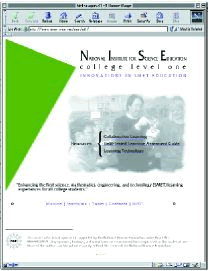

 Skip to navigation
Skip to navigation
Site Primary Navigation:
- About SDSC
- Services
- Support
- Research & Development
- Education & Training
- News & Events
Search The Site:

| EDUCATION, OUTREACH, AND TRAINING | Contents | Next
|
|
The Institute on Learning Technology Promotes Best Practices in Teaching |
|
| FEATURED Jean-Pierre R. Bayard California State University, Sacramento |
|
|
LEARNING TECHNOLOGY |
|
|
|
 |
The College Level One Web Site
The College Level One (CL-1) team of the National Institute for Science Education (NISE), based at the University of Wisconsin-Madison, is a nationwide community of science, mathematics, engineering, and technology faculty, education researchers, faculty developers, and students. |
|
|
|
LEARNING TECHNOLOGYLast August, Bayard was invited to join a group of fellows and work with the CL-1 Team to examine the impact of technology, ranging from e-mail to high-performance computing, on learning and teaching practices. Bayard hopes that this third institute, the Institute on Learning Technology (ILT), will encourage science instructors to reflect on why they use learning technologies, shape the powerful emerging technologies in learning tools, and provide students with more experience with and a better appreciation for science as a living enterprise. "We want to look beyond delivery systems," Bayard said. "We want educators to really reflect on what they are doing." Other fellows of the ILT include Susan Millar of the LEAD Center at the University of Wisconsin; Marco Molinaro and Flora McMartin from UC Berkeley; Steven Ehrmann from the Teaching, Learning, and Technology Group of the American Association for Higher Education; and John Jungck from Beloit College. "Professor Bayard's redefinition of his classroom role is part of a new paradigm that's slowly developing among faculty," says Bob Mathieu, associate director of NISE and an astronomy professor at Wisconsin. "We want to discover tools that promote student engagement rather than that simply increase information transfer." "The ILT is making the case to various academic stakeholders that there are very interesting opportunities and potentially huge learning benefits in using computers in the classroom and other computer-related activities performed by students outside the classroom," Bayard says. As with the Institute for Collaborative Learning Environments, Bayard will provide information from instructor and student interviews. So far he has visited six campuses and will have all of the case studies posted by the end of summer 2000. In the future, Bayard hopes to produce CDs and workshop products for instructors seeking opportunities to engage in active, student-centered teaching and learning with technology. "I would personally like to see the ILT become the national forum on technology-based science education," he says. --EN * |
Top | Contents | Next |